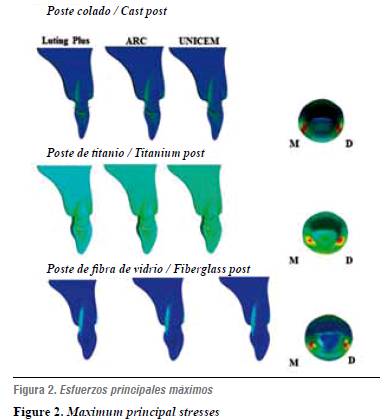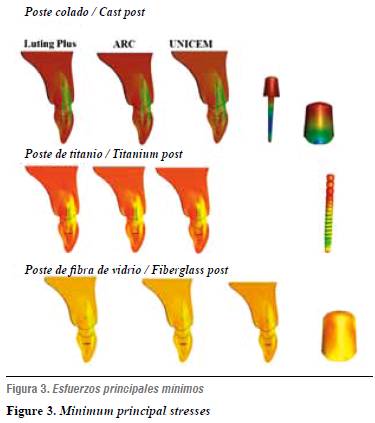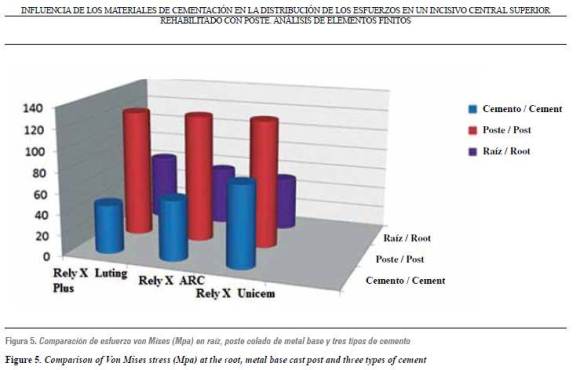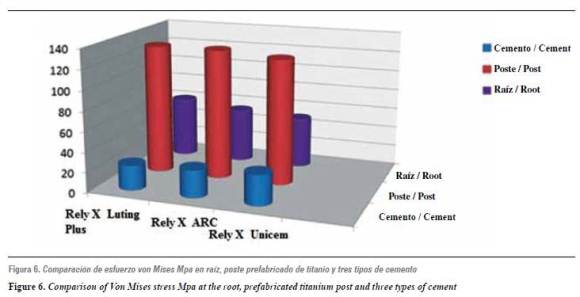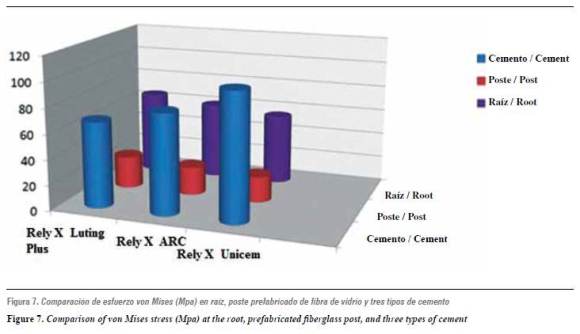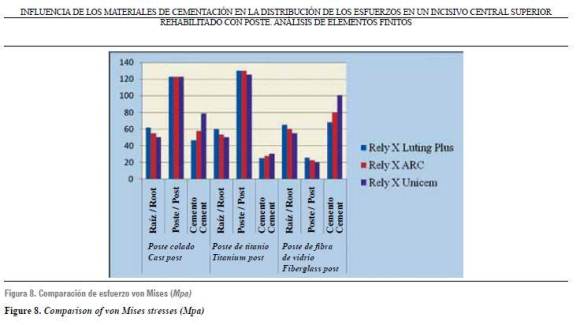Services on Demand
Journal
Article
Indicators
-
 Cited by SciELO
Cited by SciELO -
 Access statistics
Access statistics
Related links
-
 Cited by Google
Cited by Google -
 Similars in
SciELO
Similars in
SciELO -
 Similars in Google
Similars in Google
Share
Revista Facultad de Odontología Universidad de Antioquia
Print version ISSN 0121-246X
Rev Fac Odontol Univ Antioq vol.23 no.1 Medellín July/Dec. 2011
ARTÍCULOS ORIGINALES DERIVADOS DE INVESTIGACIÓN
INFLUENCE OF CEMENTATION MATERIALS IN THE STRESS DISTRIBUTION OF AN UPPER CENTRAL INCISOR RESTORED WITH POSTS. A FINITE ELEMENT ANALYSIS11
MARTHA OROZCO MENDOZA2, JUNES ABDUL VILLARRAGA OSSA3, FEDERICO LATORRE CORREA4, JULIO CÉSAR ESCOBAR RESTREPO5
1 Article derived from a research project carried out as a requirement to opt
for the title of Specialist in Adult Comprehensive Dentistry with Emphasis
in Prosthodontics, School of Dentistry, Universidad de Antioquia
2 Graduate student - Adult Comprehensive Dentistry with Emphasis in
Prosthodontics, School of Dentistry, Universidad de Antioquia. E-mail
address: martharosco@hotmail.com
3 Mechanical engineer, Uniaversidad Nacional de Colombia at Medellín,
Msc Mechanical Engineering, Universidad Simón Bolívar, Caracas-
Venezuela. E-mail address: junes@udea.edu.co
4 Dentists. Adult Comprehensive Dentistry with Emphasis in Prosthodontics,
School of Dentistry, Universidad de Antioquia, Associate Professor,
School of Dentistry, Universidad de Antioquia. E-mail address:flatorre@une.net.co
5 Dentists. Specialist in Adult Comprehensive Dentistry with Emphasis
in Prosthodontics, Facultad de Odontología, Universidad de Antioquia,
Assistant Professor, Facultad de Odontología, Universidad de Antioquia.
E-mail address:jcer75@yahoo.com
RECIBIDO: OCTUBRE 19/2010-ACEPTADO: AGOSTO 28/2011
CORRESPONDING AUTHORSFederico Latorre Correa
E-mail address: flatorre@une.net.co
Celular 314 791 45 98
Julio C. Escobar Restrepo
E-mail address: jcer75@yahoo.com
Celular 300 811 92 59
Facultad de Odontología, Universidad de Antioquia
Calle 64 N.o 52-59
Medellín, Colombia.
Orozco M, Villarraga J, Latorre F, Escobar JC. Influence of cementation materials in the stress distribution of an upper central incisor restored with posts. A finite element analysis. Rev Fac Odontol Univ Antioq 2010; 23(1): 56-75.
ABSTRACT
Introduction: in order to improve predictability of dental restorations, new cement materials with different mechanical and
physical properties are frequently developed. The purpose of this study was to evaluate and analyze the influence of cement materials in the
distribution of stresses in an upper central incisor restored with a cast intrarradicular retention element and two prefabricated elements
using the finite element method (FEM).
Methods:a modeled upper central incisor restored with three dowels (based metal cast post, titanium
prefabricated post and fiber glass) and each one cemented with resin-modified glass ionomer luting cement, self-adhesive resin luting cement
and dual cured adhesive resin. The variables included were modulus of elasticity and Poisson′s ratio for all the components of the model.
Von Misses stresses, main maximum and main minimum as well as maximum shear stress were calculated for each model.
Results:the
finite element analysis indicated that the cement influences stress distribution when the post is more flexible as in the case of prefabricated fiberglass because both post and cement receive the stress altogether.
Conclusions: as the modulus of elasticity of luting cement is higher,
the stress received among them increases, but its influence in the system depends on other variables such as the type of post that was used.
Key words: elastic modulus, luting cements, biomechanics.
INTRODUCTION
During the last two decades, adhesive procedures have been increasingly demanded for indirect restorations allowing the development of new possibilities of adhesive therapies.1, 2 As a consequence, numerous cement agents have been developed, each of them with indications and limitations. In general, cementing agents are materials that allow bonding between indirect restoration and tooth preparation3 and must comply with the following properties: biocompatibility, adhesiveness, traction resistance, radiopacity, low or no solubility, adequate film thickness, low viscosity, anticariogenic capacity, high resistance to erosion, and easy handling.4, 5
Currently, different types of cementation agents are available in the market, such as the customary zinc phosphate, polycarboxylate, conventional glass ionomer,6, 7 hybrid or resin-modified glass ionomer,8 and resinous cements, whose popularity has increased in the last years due to their good physical and mechanical properties and to their ability to adhere to enamel, dentin and porcelain.9, 10
According to their polymerization mode they can be chemo-polymerizable, photo-polymerizable, of dual polymerization, and the most recent ones are called self-etching, self-adhesive, and dual. The use chemical polymerization cements ensures polymerization without limitations in the canal′s internal area. Light photopolymerized resin cements allow enough time and control to provide post seal inside the canal, but their disadvantage is that there are some spots at the radicular canals where activation by a light source cannot be achieved. Dual cements combine advantageous properties of both chemically-cured and light-activated systems and therefore they satisfy the necessary conditions for this procedure, offering an initial fixation by photoactivation which is later complemented by the final bonding of chemical activation.11
With the arrival of self-adhesive resinous cements and one-step self-etching dual cements the objective was to improve adhesion to the dentin, decrease post-operatory sensitivity problems, improve bonding in areas that are not very sensible to light, and simplify the procedures.12, 13
All these types of cement have caused changes in the forms of cementation and in the interaction with the dentin and the various posts available; they may also have effects in stress distribution at the post-cement-dentine interphase. Scientific evidence about the behavior of these cements and their influence in the predictability of restorations and roots is not yet clear due to the difficulty of finding consensus on stress distribution and identifying whether a cement type with certain characteristics is superior to another.
The need to restore fractured teeth in a population that increases its longevity is a real one, and it requires evaluations that optimize times and efficiency and decrease the costs due to unnecessary repetitions because of incorrect use of materials.12, 13
There are multiple variables influencing the predictability of endodontically-treated roots restored with posts. There is much controversy about their results as cement is considered today a variable that may affect the final result of restoration, as suggested by Asmussen in his research.13
One of the methods of analysis currently used for the evaluation of all these variables is the finite element analysis (FEA), widely applied to restorative dentistry. This system models the conditions of amorphous and irregular structures that may be made in bidimensional (2D) or tridimensional (3D) models, being the latter more accurate and complete. These data are turned into mathematical representations and later the problem is transformed into an algebraic matrix which is solved with the help of a computer.
The use of this method offers information about tensile, compressive and cutting stresses (also called shear stresses) and about the combination of all of them, known as equivalent to von Mises stresses. The von Mises stresses are used as indicators of the possible occurrence of damage in modeled structures.13, 14
The purpose of this study was to evaluate and analyze the stress distribution (tensile, compressive, cutting and von-Mises equivalent) that occurs when using three different cementation materials in an endodontically-treated teeth restored with three different post systems and a crown entirely made of ceramic.
MATERIALS AND METHODS
A model was made of a central upper incisor and its support structure: spongy bone, cortical bone, periodontal ligament, gingiva, root, gutta-percha, resinous cement layer, posts, resin core (for prefabricated posts), lithium disilicate cap, and ceramic crown. The software CAD (Solid Works) USA was used for the final tridimensional linear model. The Solid Works simulation software, version 2009, was used for the analysis. The modeling was based on previous studies conducted by the research group on the behavior of posts in the system, initially made on photographs, natural teeth assessment and drawings made by Departament Mechanical Engineering.
The upper central incisor was chosen because of its conical root shape, for being a monoradicular tooth that usually presents high restoration averages, and because its simple shape facilitates its computer design, as it presents a relatively cylindrical pulp canal with few shape alterations and variations (its canal is circular at the middle and cervical thirds, and becomes ovoid at the apical third),15 favoring its indication for cast post as pre-fabricated. It was also selected for its anterior position in the dental arch, and for its inclination, as it is subjected to oblique forces with reference to its longitudinal axis in an angle of 45°. This angulation is the result of intersecting the longitudinal axis of the central upper incisor (111°) with the lower central incisor (90o), having as reference the Frankfurt plane (porion-orbit) and the mandibular plane respectively.16 (figure 1).
Based on the guide model, other nine models were designed representing the three cementation materials (object of study) with three different intraradicular elements (based metal cast post, titanium pre-fabricated post and fiberglass) with the same length of 10 mm.
Linear elastic analysis was performed by using tetrahedral elements (elements that allow three degrees of translational freedom and three rotational degrees for each node) in order to obtain the best possible approximation to the geometry of the parts, thus obtaining a tridimensional net of finite elements out of the model′s components. The obtained net convergence was as follows: Cast post with 844.87 nodes and 580.942 elements; titanium post with 335.804 nodes and 220.702 elements, and fiberglass post with 640.286 nodes and 493.755 elements. Each group of nodes and elements is the same with all the cementation materials.
The load applied to the models was arbitrary of 200 N, evenly distributed along the lingual surface, simulating the loads generated during some masticatory movements.
The mechanical properties of the elements composing the numeric model were obtained from previous studies reported in the specialized literature. Thus the model had isotropic properties for: ceramics, base metal post, titanium post, gutta-percha, dentine, resin, periodontal ligament, and resinous cement, as well as orthotropic properties for cortical bone, soft bone and fiberglass post (table 1).
Geometry
The central upper incisor′s root was modeled with a core of 2 mm of remnant crown structure, taking
a bevel of 1 mm around its periphery in order to produce the ferrule effect as recommended by the specialized literature, both in the cast posts and the prefabricated ones.27
The root was given a conic shape in order to facilitate modeling and a 5 mm diameter in all the models so that the results wouldn’t be affected due to the great variability existing in anatomy and in radicular dimensions from one individual to another.
For the root canal design, it was taken into account that the pulp canal width would not exceed one third of the radicular width in its narrower section, having at least 1 mm of healthy dentine around it, especially in the apical region.3
The four apical millimeters of the radicular canal were modeled with the properties of gutta-percha (a filling material for endodontics) thus maintaining the minimum amount of remnant filling to avoid filtration, as described in the literature.27
For the rest of the radicular canal and its coronal portion, a post was modeled with the three different types of materials to be studied. The post was designed with a crown diameter of 1.6 mm and an apical diameter of 1.1 mm, fitting the internal anatomy of the radicular canal with its apical portion rounded. The posts were cemented with resin-modified glass ionomer (Rely XTM luting of 3M ESPE), resinous cement (RelyXTM ARC of 3M ESPE), and universal self-adhesive resinous cement (RelyXTM UNICEM 3M ESPE) with cement thickness of 40 Μm in the case of the cast post and heterogeneous thickness of 50 Μm for the prefabricated posts due to their geometry, thus guaranteeing the minimum thickness previously mentioned.
The core configuration maintained the proportions of the preparation of a central upper left incisor′s complete crown in ceramics, which requires an average axial reduction of 1.8 mm. This ensured the adequate space for modeling the ceramic crown as follows: The porcelain thickness was of between 1.5 and 1.8 mm, except at the incisal portion where it was of 2.0 mm. All these parameters allowed the restoration to meet the recommended esthetic and thickness requirements for material resistance and thus avoid overcontours.
The periodontal ligament was designed taking into account isotropic properties (materials with the same characteristics in all directions), with 0.2 mm thickness at the root periphery, and it was located 1.5 mm from the cementoenamel junction.
The alveolar bone design included the trabecular bone that forms the interior of the maxillary body and the cortical bone that surrounds both the maxillary and the alveolus. Both structures were considered as having orhtotropic properties (materials with different characteristics at the x, y, and z axes). The osseous height was of 18 mm from the alveolar crest up to the maxillary base portion. The cortical bone was of 1 mm thick in the peripheral zone from the basal region and of 0.5 mm towards the alveolus′ internal region.
The teeth had a total length of 23 mm; the crown had 9 mm of length and 8 mm of width, and the root had 14 mm of length with a 5 mm diameter.
In order to calculate stress and displacement by using the model, elastic constants were used (Young′s elastic model: a property of the materials equivalent to the slope of stress curve against the elastic range deformation and Poisson′s ratio, which is an elastic constant of materials indicating the relation between axial and lateral deformation).
RESULTS
Once the tridimensional mathematic model of an upper central incisor endodontically treated and restored with three posts and cementation agents was completed, the simulation was run with the finite elements software and the following results were obtained:
In most cases, the cast post (the material with the greatest elasticity modulus in this study) presented the minimum stress distribution towards the root, followed by the prefabricated titanium post and the fiberglass post. The maximum principal stresses (tensiles) of the three posts cemented with resinmodified glass ionomer (luting plus), resinous cement (RC) and self-adhesive cement (UNICEM) were observed at the internal cervical section of the lithium disilicate cap towards mesial and distal, as shown in figure 2.
The minimum principal stresses (compressive) in the case of the cast post were observed at the external section of the lithium disilicate cap towards vestibular and at the pin of the post itself. In the case of the titanium post, the stress converged on the openings due to the actual configuration or geometry of the post; finally, in the fiberglass prefabricated post, the stress converged on the lithium disilicate cap at the external section at mesial, distal and cervical, as shown in figure 3.
The maximum shear stresses are observed at the termination line, internal section towards vestibular, and the tendency is for the shear stress to slightly reduce as the post elasticity modulus increases, while in the fiberglass post it occurred towards vestibular and palatal, as shown in figure 4.
Table 2 and figure 5 show the comparisons between von Mises stress, maximum and minimum principal root stresses, cast post, and the cement, showing greater stress distribution in the cast post and, as the cement′s elasticity modulus increases, the stress concentration at the root decreases.
The concentration of von Mises stresses in the post remains similar in the three models, except at the root, which reduces the concentration as the type of cement changes from Rely X luting plus to Rely X ARC up to Rely X UNICEM.
The latter receives the greater von Mises stress in this model, and it also receives the greater tensile and compressive stresses, showing the difference of the greater compressive, since it doubles the value of the X luting plus cement.
As the cement increases the von Mises stresses value, their concentration decreases at the roots with cast posts.
In terms of the maximum principal stresses, their concentration in the root does not substantially change, but in the compressive stresses it maintains the tendency shown with the von Mises stresses, where it decreases its concentration while it increases in the cements (both in the principal minimums and the principal maximums), being this difference more prominent in the principal minimums.
Concerning the shear stresses, there is a greater concentration of them in the cast post, and the cement receives almost three times less shear stresses than the post, being the root located in between them (table 2).
Titanium post cemented with resin-modified glass ionomer, resinous cement, and selfadhesive cement
Table 3 and figure 6 show the comparisons between von Mises stress, maximum and minimum principal root stresses, titanium post, and the cement, showing greater stress distribution in the titanium post. Von Mises stress distribution in the model with titanium post shows a tendency similar to the model with cast post, it presents reduction at the root, and stress increase in the model with Rely X luting plus cement up to the model with Rely X UNICEM.
Concerning shear stresses, there is a greater concentration of them in the titanium post, and the cement receives almost three times less shear stress than the post, being the root in between both stresses; this behavior is very similar to the cast post (table 3).
Fiberglass post cemented with resin-modified ionomer glass, resinous cement, and self-adhesive cement
Table 4 and figure 7, show the comparisons between von Mises stress, maximum and minimum principal root stresses, the fiberglass post, and the cement, showing greater stress distribution in the cement and the root.
The resinous cement increases with the same tendency as in the other models, and presents a substantial difference in the von Mises stresses, where it goes from the Rely X luting plus cement with 68.08 Mpa to the Rely X Unicem cement with 100.92 Mpa. In these models, the fiberglass posts remain with similar von Mises, principal maximum and principal minimum stress distribution, being this the only model in which the post is the one that receives the less amount of stress in relation to shear stresses; there is greater concentration at the root and the cement, contrary to the other models, but in average both the root and the cement proportionally receive similar stress.
When a correlation among the von Mises stresses (table 5 and figure 8) of the three types of posts with different cements was made, it was evident that the titanium post, along with the cast post, received the greatest stresses compared to the one of fiberglass, with a significant difference between the values of these two and the one of fiberglass. The post-cement relationship shows that, while in the post cast the stress in the cement increased, when a cementation material with a greater elasticity modulus was used, the stress in the post did not vary. In the titanium and fiberglass posts, the same tendency remains: little variation of the von Mises in the post, and von Mises increase in the cement, proportional to its change in the elasticity modulus.
DISCUSSION
Restoration of endodontically-treated teeth is a common problem in restorative dentistry, related to the loss of dental structure in these teeth. The main objective of a post is to maintain the material of the resin core, in order to provide retention for the prosthetic restoration. Evaluating the stresses is important, especially in the anterior teeth, where the loads are transversal and the flexural behavior of the post must be taken into account because magnitude and incisal load angle greatly affect the long-term success of these restoration systems. This is the reason why this study analyzed the mechanical behavior of a central maxillary incisor endodontically treated and restored with different posts, cementation materials, and a crown totally made of ceramics, by means of a finite elements analysis assessing the diverse stresses (tensiles, compressive, shear, and von Mises equivalent).
These results are found in the three types of posts: cast, titanium and fiberglass, although with an important difference in the fiberglass posts, where the cementing agents receive greater stress than the post itself, and this would mean that, when a post of low elasticity modulus is used, the cement would play a more important role and, as the elasticity modulus of the cements increases, stress distribution at the root decreases, as shown in (table 5).
Stress intensification in the cements, from the one of the lowest value (Rely X luting plus), to the Rely X ARC up to the Rely X UNICEM, is proportionate to the elasticity modulus, indicating that the use of cements with greater elasticity modules would have greater clinical implications in combination with posts of lower elasticity modulus, since they reduce stress on the root.
This agrees with the findings by Asmussen13 in 2005 and Sidoli28 in1997, who found out that the stress on the dentin decreases if the elasticity modulus of the post increases, depending on diameter, length, and whether they are cemented with resinous cements.
Other studies, such as the one by L Li-li29 et al in 2006 who, by means of a 3D finite elements analysis, evaluated stress distribution of a central maxillary incisor restored with titanium post and cements with different elasticity modulus (ionomer cement, zinc polycarboxylate, zinc phosphate cement, resinous cement, Panavia F), demonstrate that increasing the elasticity modulus of cement decreases the stress value at the dentine, validating the principle by which the elasticity modulus is indeed one of the important parameters for biomechanically evaluate cementing agents. These authors also state that cements with elasticity modulus similar to the dentine may reduce stress at the root before external forces and therefore there would be a more favorable biomechanical behavior reducing the incidence of root fracture.
The findings of the present study agree with the behavior of posts and cementing agents related to elasticity modulus, as suggested by Asmussen, Sidoli and L Li li, but do not agree with those conclusions that indicate that an elasticity modulus similar or different to the dentine would complicate the prognosis of a root. According to the findings of this study, the individual behavior of each model may be analyzed; however, the risk of fracture at the root may not be deducted from this type of study because it is a linear analysis, but a tendency of decreasing the stress at the three roots may actually be observed when the elasticity modulus of the cementing agents is increased.
It is necessary to consider that the study by Ll Li-li is a linear one, applying a force of 100 N, without taking into account the fluency limit of the materials or the tissues, and with a model focused on a weak tooth, so that some conclusions cannot be extrapolated, like the one that indicates favorability of certain types of cements or the ones that assign them properties as system protectors, because the results and the methodology of this article cannot be derived from these conclusions. In 2005, Lanza30 et al concluded that steel
In 2005, Lanza30 et al concluded that steel posts are more harmful to the root as they cause fracture, and that the cementing agent does not improve stress distribution due to the extreme rigidity of the post. In carbon posts, the cement′s elasticity modulus significantly affects the capacity of the system to absorb stresses. They finally conclude that a high elasticity modulus for both the cementing agent and the post is harmful to the whole tooth′s system, as it does not allow homogenous stress distribution.
Although these authors present some explanation, their article lacks data for the analysis and exposition of their propositions; it is also important to consider that theirs is a linear study, and therefore whether one system is superior to the other is something that cannot be judged. Although it has been demonstrated that in a more rigid system stress distribution is heterogeneous, our study shows that stresses received by the root in the three types of systems are similar, and therefore a linear study could not refer to the possibility of fracture or to a system harmful to a tooth.
The results of our study validate the importance of the elasticity modulus in dental materials for the assessment of the biomechanical behavior at the post/ cement/dentine interphase. This FEA study allows the analysis of stress distribution in the post, the root and the cement of an endodontically-treated tooth restored with a crown totally made of ceramics because it enables observation of stress distribution in nine models, as well as the influence of the different cementing agents and the variables of the posts in the three systems. It is important to note that, due to the different geometry of the three systems, an analysis of their individual behavior may be made, but one should be cautious when expressing concepts pro or against any of the systems due to the differences among them.
There are clinical variables not included in these models, as the lack of homogeneity that may occur in the cementing agents, as shown in the study by Watzke et al in 2008,31 that may be due to a difference in the cementation methodology, which could generate clinical behavior differences and this was not considered in these models. It has also been considered that there may be differences in terms of adherence and resistance to the posts removal, according to their material, either cast or fiberglass, as Kremeier et al stated in 2008,32 although their study failed to demonstrate these differences. In another study, Kececi et al in 200833 evaluated adherence showing differences among the cements, but they only evaluated fiberglass posts, and yet in another study, in 2010 Edermir34 found advantages in the use of fiberglass posts over carbon fiber posts, but he did not find adhesive differences among the cements. Following the findings of those studies, this project assumed that adherence is similar in the three models, and the findings concerning shear stresses revealed that the models with more rigid posts concentrate more in the stresses at the pin than at the core itself, generating a greater strength of removal—differently to the fiberglass posts.
Schmitter M et al, 2010,35 consider resinous cements important for the adequate functioning of the post bonding and its ferrule effect, contrary to what would happen with conventional cements, such as ionomer. This study did not consider such adhesive difference, which could either favor or discredit any of the cements.
Dejak B et al, 2011,36 suggest that cast posts transmit less stress to the cements and the dentine than fiberglass posts, thus agreeing with this study; the difference is that they used a single cement and the properties of the posts of higher elasticity modulus were different, such as the one of fiberglass. Nevertheless, regardless of these differences, both studies give a similar explanation to this kind of restorations.
It is important to perform a study that can compare the behavior of cements with higher elasticity modulus, such as zinc phosphate cement. The analysis of stresses under this experimental condition may provide some guidelines for the clinical practice.
CONCLUSIONS
Although with some limitations in this study, the following conclusions may be drawn:
Models with cast posts and titanium posts have similar behavior for the concentration of von Mises stresses, differently to the models with fiberglass posts.
Although some difference occurs whether the post is rigid or flexible, the difference of the stresses transmitted to the root in the three systems is not noticeable.
The influence of the cementation material is determined by its elasticity modulus. The higher it is, the more importance it has in all the system.
1. Braga R, Cesar PF, Gonzaga CC. Mechanical properties of resin cements with different activation modes. J Oral Rehabil 2002; 29: 257-262. [ Links ]
2. Yang B, Ludwig K, Adelung R, Kern M. Micro-tensile bond strength of three luting resins to human regional dentin. Dent Mater 2006; 22: 45-56. [ Links ]
3. Academy of Prosthodontics. The glossary of prosthodontic terms. J Prosthet Dent 2005; 94(1): 21-38. [ Links ]
4. Rosentiel SF, Land MF, Crispin BJ. Dental luting agents: a review of the current literature. J Prosthet Dent 1998; 80: 280-301. [ Links ]
5. White SN, Yu Z, Yom JF, Sangsurarak S. In vivo marginal adaptation of cast crowns luted with different cements. J Prosthet Dent 1995: 74: 25-32. [ Links ]
6. Pegoraro T, da Silva N, Carvalho R. Cements for use in esthetic dentistry. Dent Clin N Am 2007; 51: 453-471. [ Links ]
7. Donovan TE, Becker W, Brodine AH, Burgess JO, Cronin RJ, Summith JB. Annual review of selected dental literature: Report of the Committee on Scientific Investigation of the American Academy of Restorative Dentistry. J Prosthet Dent 2007; 98: 36-67. [ Links ]
8. Davidson CL, Mjor IA. Advances in glass ionomer cement. Quintessence 1999: 41-43. [ Links ]
9. Ergin S, Gemalmaz D. Retentive properties of five different cements on base and noble metal copings. J Prosthet Dent 2002;88: 491-497. [ Links ]
10. Díaz-Arnold AM, Vargas MA, Haselton DR. Current status of luting agents for fixed prosthodontics. J Prosthet Dent 1999;81(2): 135-141. [ Links ]
11. Ceballos L, Garrido M, Fuentes V, Rodríguez J. Mechanical characterization of resin cements used for luting fiber posts by nanoindentation. Dent Mater 2007; 23: 200-205. [ Links ]
12. Munck J, Vargas M, Van Landuy K, Hikita K. Bonding of an auto-adhesive luting material to enamel and dentin. Dent Mater 2004;20: 963-971. [ Links ]
13. Asmussen E, Peutzfeldt A, Sahafi A. Finite elements analysis of stresses in endodontically treated, dowel-restored teeth. J Prosthet Dent 2005; 94: 321-329. [ Links ]
14. Peláez A, Mejía S. Conceptos básicos de modelación matemática y simulación computacional de sistemas biológicos. Una herramienta útil para la docencia y la investigación. Ces Odontol 2000;13: 51-55. [ Links ]
15. Root canal anatomy: an online study guide. JOE Editorial Board [Corporate Author]. J Endod 2008; 34(5) supl: e7- e16. [ Links ]
16. Moyer R, Bookstein F, Hunter WS. Analysis of the craniofacial skeleton: Cefalometrics. In: Handbook of orthodontics. 4.ª ed. Ann Arbor: Year book medical;1988. p. 247-301. [ Links ]
17. Reinhardt RA, Krejci RF, Pao YC, Stannard JG. Dentin stress in post-reconstructed teeth with diminishing bone support. J Dent Res 1983; 62: 1002-1018. [ Links ]
18. Heoung-Jae Chun, Ha-Shik Shin, Chong-Hyun Han, Soo- Hong Lee. Influence of implant abutment type on stress distribution in bone under various loading conditions using finite element analysis. Int J Oral Maxillofac Implants 2006; 21: 195-202. [ Links ]
19. Ivoclar Vivadent. IPS e. Max. Ficha técnica. [ Links ]
20. Ivoclar Vivadent. IPS e. Maxpress. Ficha técnica. [ Links ]
21. Maceri F, Martignoni M, Vairo G. Mechanical behavior of endodontic restorations with multiple prefabricated post: A finite element approach. J Biomech 2006; 40(11): 2386-2398. [ Links ]
22. Torbjorner A, Franssin B.A literature review on the prosthetic treatment of structurally compromised teeth. Int J Prosthodont 2004; 17: 369-376. [ Links ]
23. Coltene/Whaledent. Post®. Ficha técnica. [ Links ]
24. 3M ESPE. RelyTM luting cement. Ficha técnica. [ Links ]
25. 3M RelyXTM ARC. Cemento de resina adhesivo. Perfil técnico del producto.p.1-44. Ficha técnica. [ Links ]
26. 3M ESPE. RelyXTMUNICEM. AplicapTM/MaxicapTM. Cemento autoadhesivo universal de resina. Ficha técnica. [ Links ]
27. Turner CH, Cowin SC, Rho Young J, Ashman RB, Rice J. The fabric dependence of the orthotropic elastic constantans of cancellous bone. J Biomechanic 1990;23:549-561. [ Links ]
28. Sidoli GE, King PA, Setchell D. An in vitro evaluation of a carbon fiber-based and core system. J Prosthet Dent 1997; 78: 5-9. [ Links ]
29. Li-li L,Zhong-yi W, Zhong-cheng B, Yong M, Bo G, Haitao X, Bing Z, Yong Z, Bing L. Three-dimensional finite element analysis of weakened roots restored with different cements in combination with titanium alloy posts. Chin Med J 2006; 119(4): 305-311. [ Links ]
30. Lanza A, Aversa R, Rengo S, Apicella D, Apicella A. 3D FEA of cemented steel, glass and carbon posts in a maxillary incisor. Dent Mat 2005; 21: 709-715. [ Links ]
31. Watzke R, Blunck U, Frankenberger R, Naumann M. Interface homogeneity of adhesively luted glass fiber post. Dent Mat 2008; 4: 1512-1517. [ Links ]
32. Kremeier K, Fasen L, Klaiber B, Hofmann N. Influence of endodontic post type (glass fiber, quartz fiber or gold) and luting material on push-out bond strength to dentin in vitro. Dent Mat 2008; 4: 660-666. [ Links ]
33. Kececi AD, Kaya U, Adanir N. Micro push-out bond strengths of four-reinforced composite post systems and 2 luting materials. Oral Surg Oral Med Oral Pathol Oral Radiol Endod 2008; 105: 121-128. [ Links ]
34. Edermir U, Mumcu E, Topcu FT, Yildiz E. Micro push-out bond strengths of 2 fiber post types luted using different adhesive strategies. Oral Surg Oral Med Oral Pathol Oral Radiol Endod 2010; 110: 534-544. [ Links ]
35. Schmitter M, Rammelsberg P, Lenz J, Scheuber S, Schweizerhof K, Rues S. Teeth restored using fiber-reinforced posts: In vitro fracture tests and finite element analysis. Acta Biomaterialia 2010; 6: 3747-3754. [ Links ]
36. Dejak B, Mlotkowski A. Finite element analysis of strength and adhesion of cast post compared to glass fiber-reinforced composite resin post in anterior teeth. J Prosthet Dent 2011; 105: 115-126. [ Links ]











 text in
text in 



